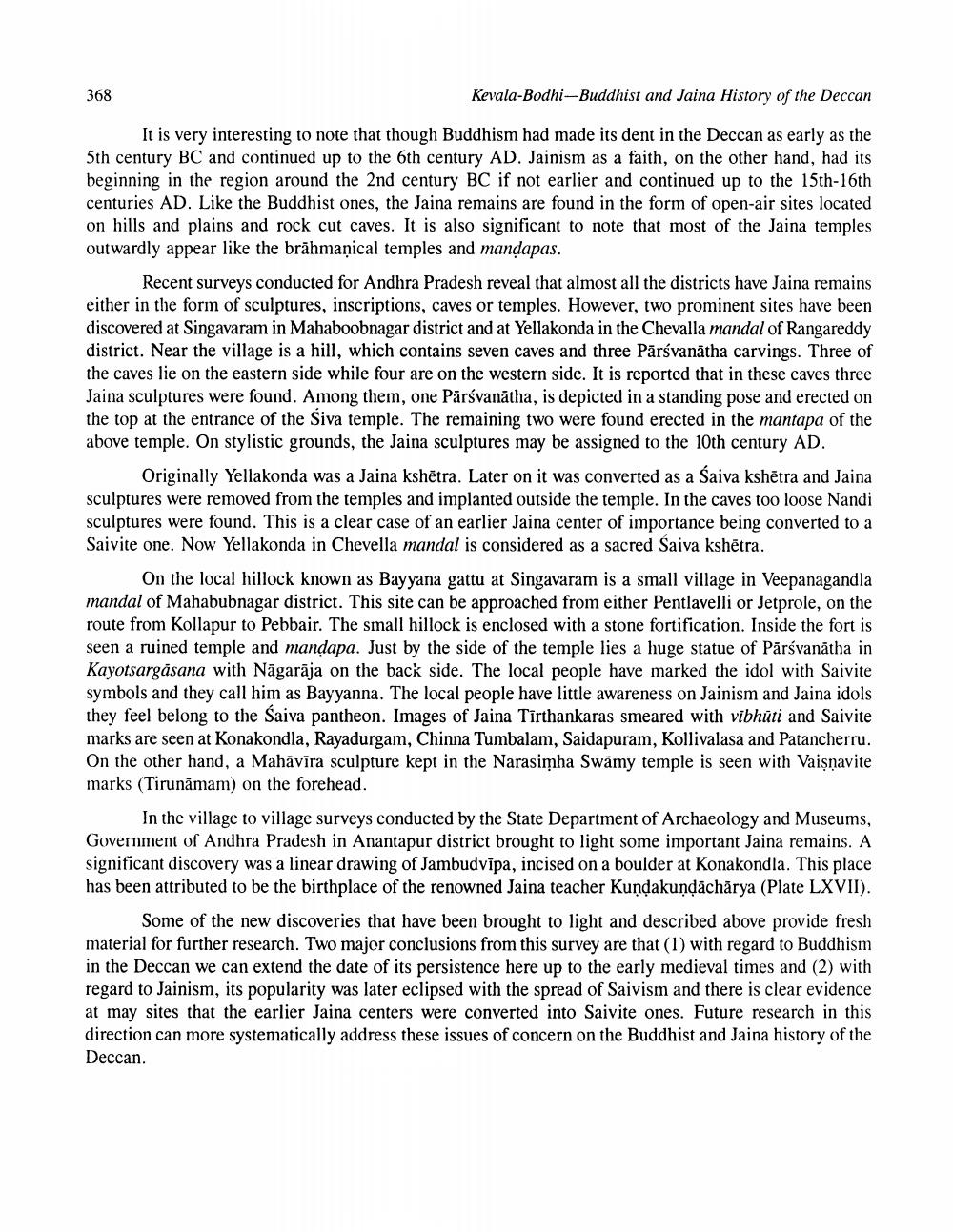________________
368
Kevala-Bodhi-Buddhist and Jaina History of the Deccan
It is very interesting to note that though Buddhism had made its dent in the Deccan as early as the 5th century BC and continued up to the 6th century AD. Jainism as a faith, on the other hand, had its beginning in the region around the 2nd century BC if not earlier and continued up to the 15th-16th centuries AD. Like the Buddhist ones, the Jaina remains are found in the form of open-air sites located on hills and plains and rock cut caves. It is also significant to note that most of the Jaina temples outwardly appear like the brāhmaṇical temples and mandapas.
Recent surveys conducted for Andhra Pradesh reveal that almost all the districts have Jaina remains either in the form of sculptures, inscriptions, caves or temples. However, two prominent sites have been discovered at Singavaram in Mahaboobnagar district and at Yellakonda in the Chevalla mandal of Rangareddy district. Near the village is a hill, which contains seven caves and three Pārsvanātha carvings. Three of the caves lie on the eastern side while four are on the western side. It is reported that in these caves three Jaina sculptures were found. Among them, one Pārsvanātha, is depicted in a standing pose and erected on the top at the entrance of the Siva temple. The remaining two were found erected in the mantapa of the above temple. On stylistic grounds, the Jaina sculptures may be assigned to the 10th century AD.
Originally Yellakonda was a Jaina kshētra. Later on it was converted as a Saiva kshētra and Jaina sculptures were removed from the temples and implanted outside the temple. In the caves too loose Nandi sculptures were found. This is a clear case of an earlier Jaina center of importance being converted to a Saivite one. Now Yellakonda in Chevella mandal is considered as a sacred Saiva kshētra.
On the local hillock known as Bayyana gattu at Singavaram is a small village in Veepanagandla mandal of Mahabubnagar district. This site can be approached from either Pentlavelli or Jetprole, on the route from Kollapur to Pebbair. The small hillock is enclosed with a stone fortification. Inside the fort is seen a ruined temple and mandapa. Just by the side of the temple lies a huge statue of Pārsvanātha in Kayotsargāsana with Nägarāja on the back side. The local people have marked the idol with Saivite symbols and they call him as Bayyanna. The local people have little awareness on Jainism and Jaina idols they feel belong to the Saiva pantheon. Images of Jaina Tīrthankaras smeared with vibhūti and Saivite marks are seen at Konakondla, Rayadurgam, Chinna Tumbalam, Saidapuram, Kollivalasa and Patancherru. On the other hand, a Mahāvīra sculpture kept in the Narasimha Swāmy temple is seen with Vaişnavite marks (Tirunāmam) on the forehead.
or
In the village to village surveys conducted by the State Department of Archaeology and Museums, Government of Andhra Pradesh in Anantapur district brought to light some important Jaina remains. A significant discovery was a linear drawing of Jambudvīpa, incised on a boulder at Konakondla. This place has been attributed to be the birthplace of the renowned Jaina teacher Kundakundáchārya (Plate LXVII).
Some of the new discoveries that have been brought to light and described above provide fresh material for further research. Two major conclusions from this survey are that (1) with regard to Buddhism in the Deccan we can extend the date of its persistence here up to the early medieval times and (2) with regard to Jainism, its popularity was later eclipsed with the spread of Saivism and there is clear evidence at may sites that the earlier Jaina centers were converted into Saivite ones. Future research in this direction can more systematically address these issues of concern on the Buddhist and Jaina history of the Deccan.




